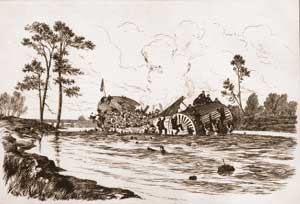| Emily's Biography | The Oeuvre | Flannigan Bio | The Inventions | ||
| Associated Figures | Literary Contest | The Frolics Store | About the Circle |
|
|||||||||||
| Emily Chesley - a biography | |||||||||
|
|
|||||||||
|
Peruse her biography:Formation (1856-1880)London, Ontario (1880-1904) Travels (1904-1919) A Long Twilight (1919-1948) ...Chesleyan Timeline ...The Oeuvre
|
A Woman Of Means
Emily Chesley Comes to London, Ontario
|
||||||||
 |
| Though filled with more than enough heart-ache, Emily's life was to see even more tragedy in that palindromic year, 1881. Illustration showing the Victoria Disaster. (Reproduced from the National Library of Canada's website (www.nlc-bnc.ca).) |
 surface of the rather shallow Thames river. Emily’s life
was spared due to one of her Uncle’s inventions, the Bloomer
Disrobing Solution (also known as "the
rogue’s friend" or more simply "the snap").
Intended as an economical way for women to quickly relieve themselves
of the several layers of heavy bloomers, the snap consisted of a
network of tension wires, a spring, and an unobtrusive switch located
in the small of the back.
surface of the rather shallow Thames river. Emily’s life
was spared due to one of her Uncle’s inventions, the Bloomer
Disrobing Solution (also known as "the
rogue’s friend" or more simply "the snap").
Intended as an economical way for women to quickly relieve themselves
of the several layers of heavy bloomers, the snap consisted of a
network of tension wires, a spring, and an unobtrusive switch located
in the small of the back. Employing the Bloomer Disrobing Solution Emily was able to shuffle off her soaked garments. Now wearing only a boostier and one of her uncle’s other inventions, the thong, Emily searched in vain for Lars. Nearing exhaustion she swam to shore, followed by a number of young London men. One of the young men, Phenias Hornblatt, eventually became one of Canada’s leading essayists. He recalled the incident years later in his memoirs with the story Moon in the River.
. . . The Victoria died on her side with a final belch of smoke and flame from her funnels as the coal stirred in her belly. From everywhere around us in the river there arose cry of desperation. In the chaos I was quite disoriented and sure that I might well perish with the other confused young men who were splashing about. Then my eyes fell on the most incredible sight, a curvaceous buttock breaking the surface of the muddy Thames. It shone white in the May sunshine. Then it was gone. Then, a stir a few yards away and there it was again. Then again it was gone. Then, right in front of me, like an Arthurian vision of the Lady of the lake, she surfaced. She looked like a wild desperate Venus searching for her Adonis. She turned and labored toward shore again displaying that heavenly flank. We followed . . .
 |
| Phenias Hornblatt, seen here
in 1898. Hornblatt grew his famously ludicrous facial hair after
Emily told him about her drowned lover, Lars Horstadt, and his
huge handle bar mustache that she so much admired .
In his 1921 biography, Hey Hornblatt!, Justin Theway wrote: "Phenias never outgrew his infatuation with the Speculative Songstress of the Southwest, and refused to shave off his silly moustaches, though it caused him to be a social outcast at times." |
Phenias Hornblatt, and the other young men who followed, later credited Emily with leading them out of the confusion to safety. But there was to be no hero honors for Emily ashore as her attire caused a major scandal. The Thong Bank Incident was considered so outrageous that it was expunged from contemporary accounts of the Victoria Disaster. Some still say it never happened.
There were still great times ahead for Emily and her kin. In Emily’s midst there was a man whose genius, inventiveness, and shear entrepreneurial drive would carry Ontario and all of Canada into the 20th century. A man whose mechanical knowledge and political acumen would lead to this country to harnessing and taming the great powers of nature. A man who, in short, would make a real difference for future generations of Canadians. Unfortunately, Sir Adam Beck is the subject of other biographies and shall be mentioned no more in this one. Michael Flannigan did OK too.
"Scholarship" by Thuder
Next: The Dark Side of the Moon
Emily's Bio | The
Oeuvre | Flannigan
Bio | Inventions
Associated Figures
| Literary Contest
| The
Frolics Store
About the Circle | Search
this Site | Home
Join our mailing list or send us email.
All written material, graphics, logo, and html coding
© copyright 2003-2005 The Emily Chesley Reading Circle
Web Monkey: Mark A. Rayner
